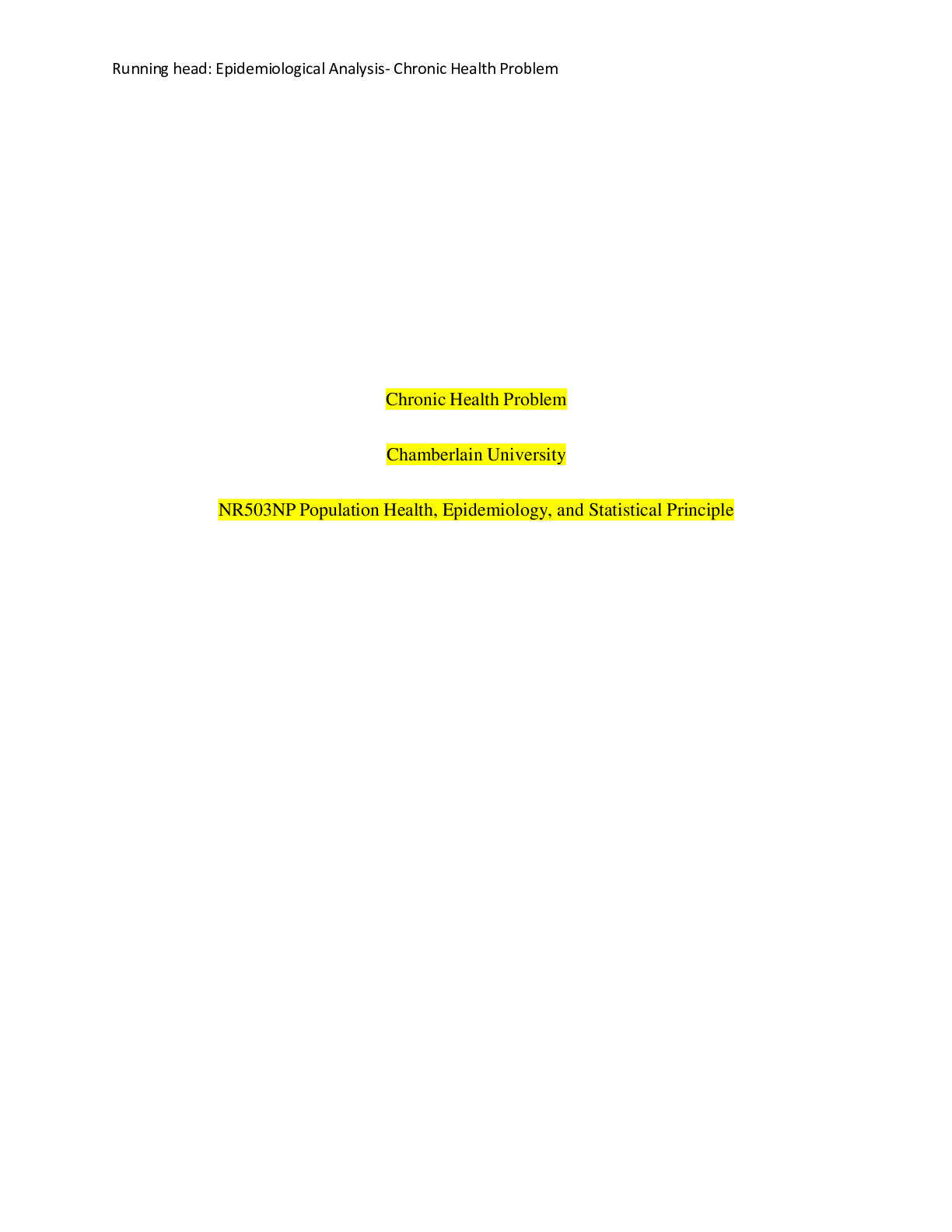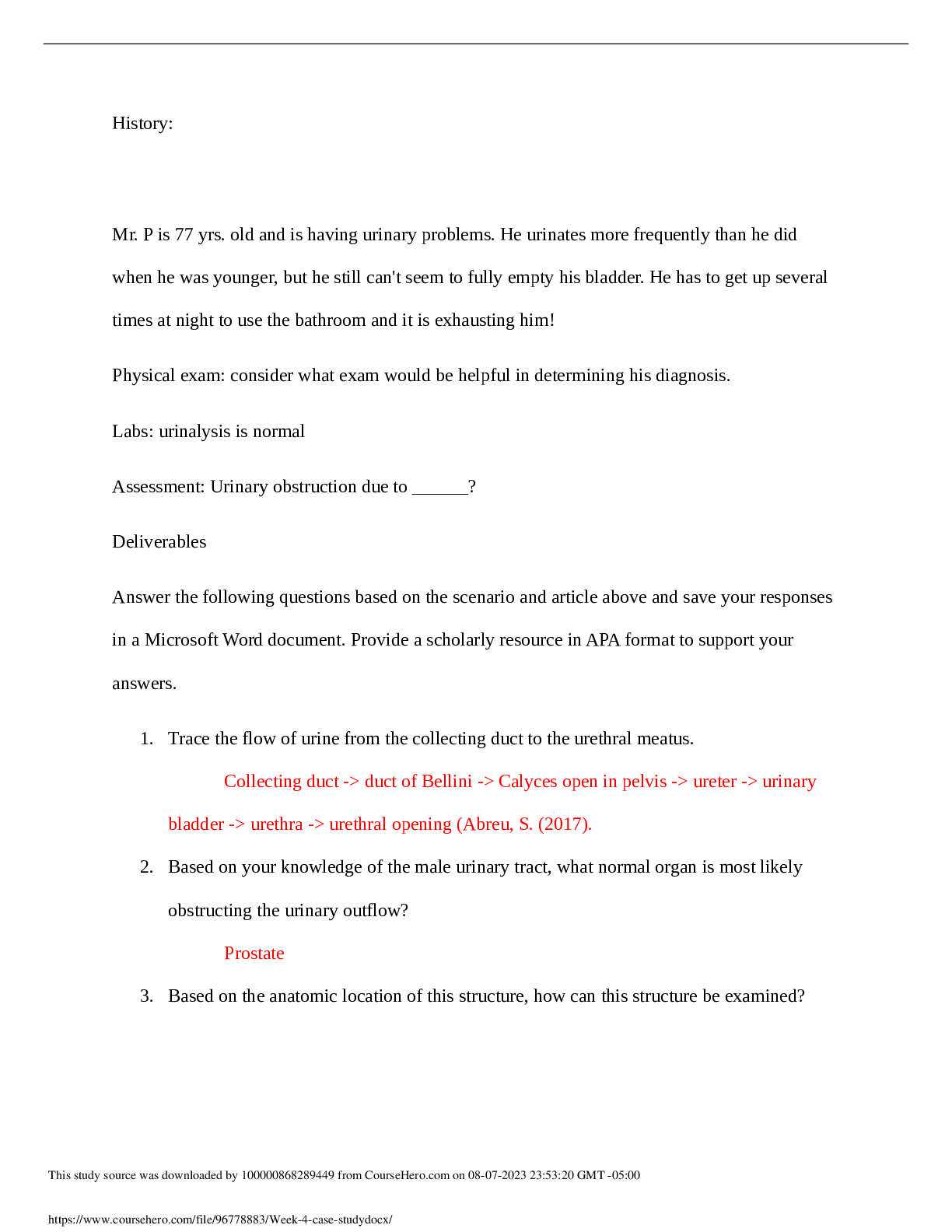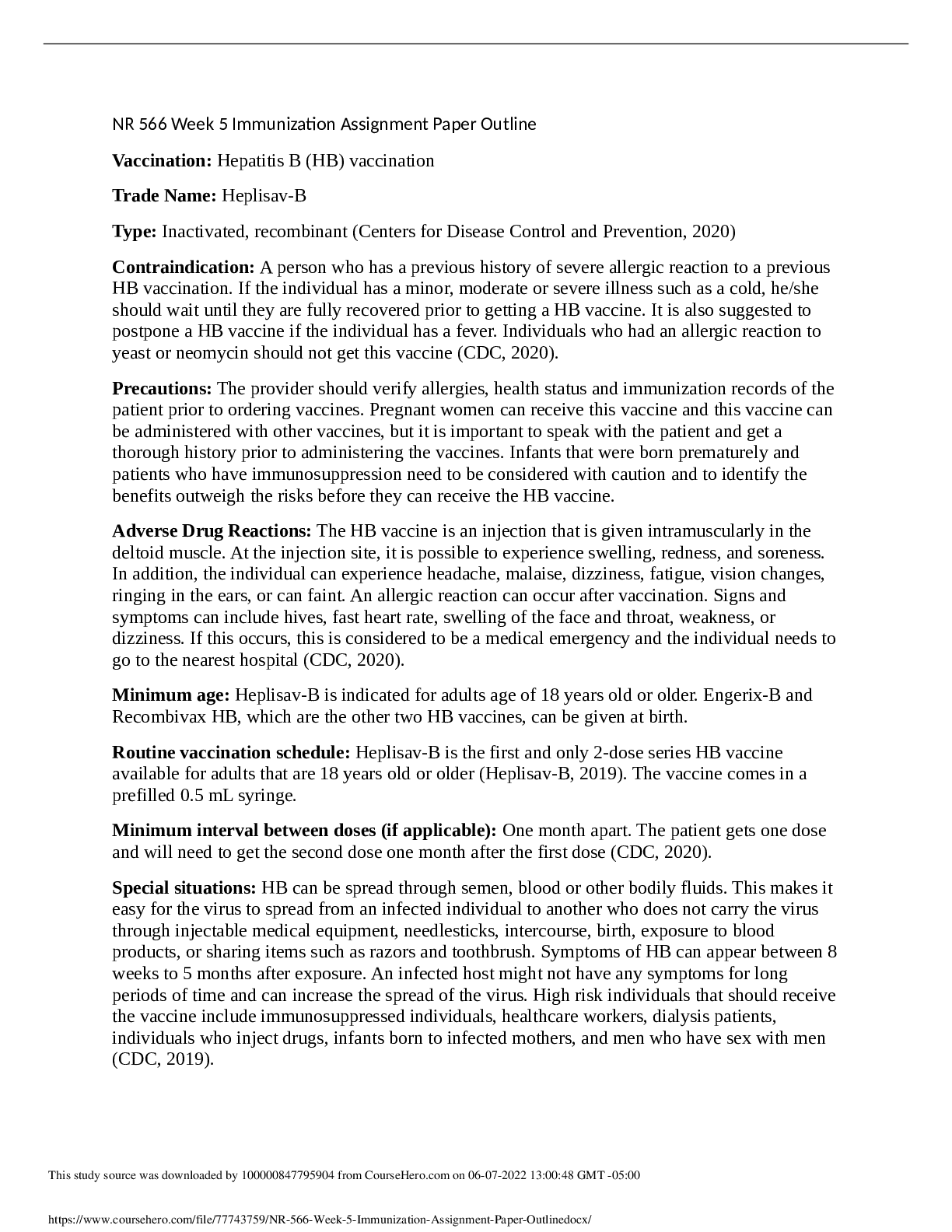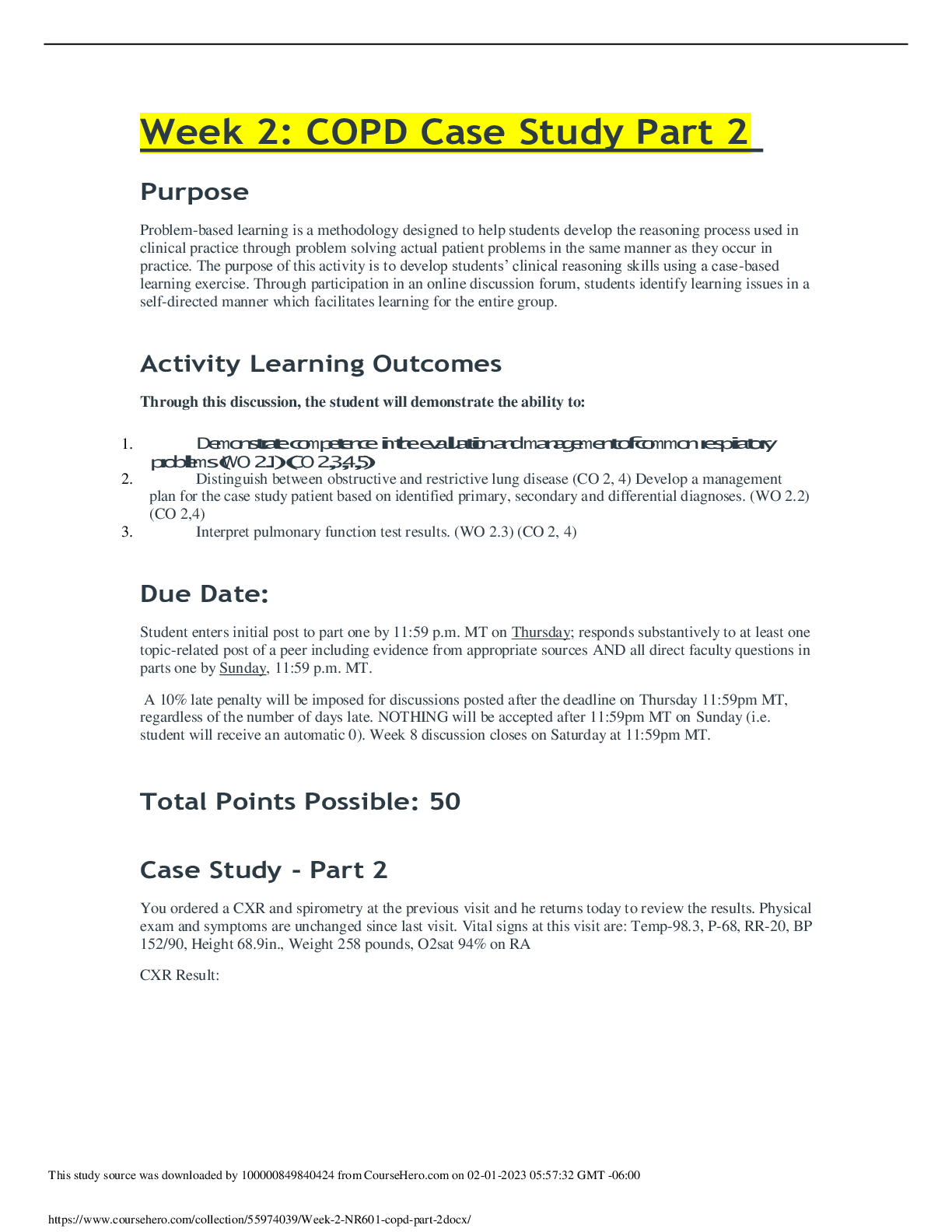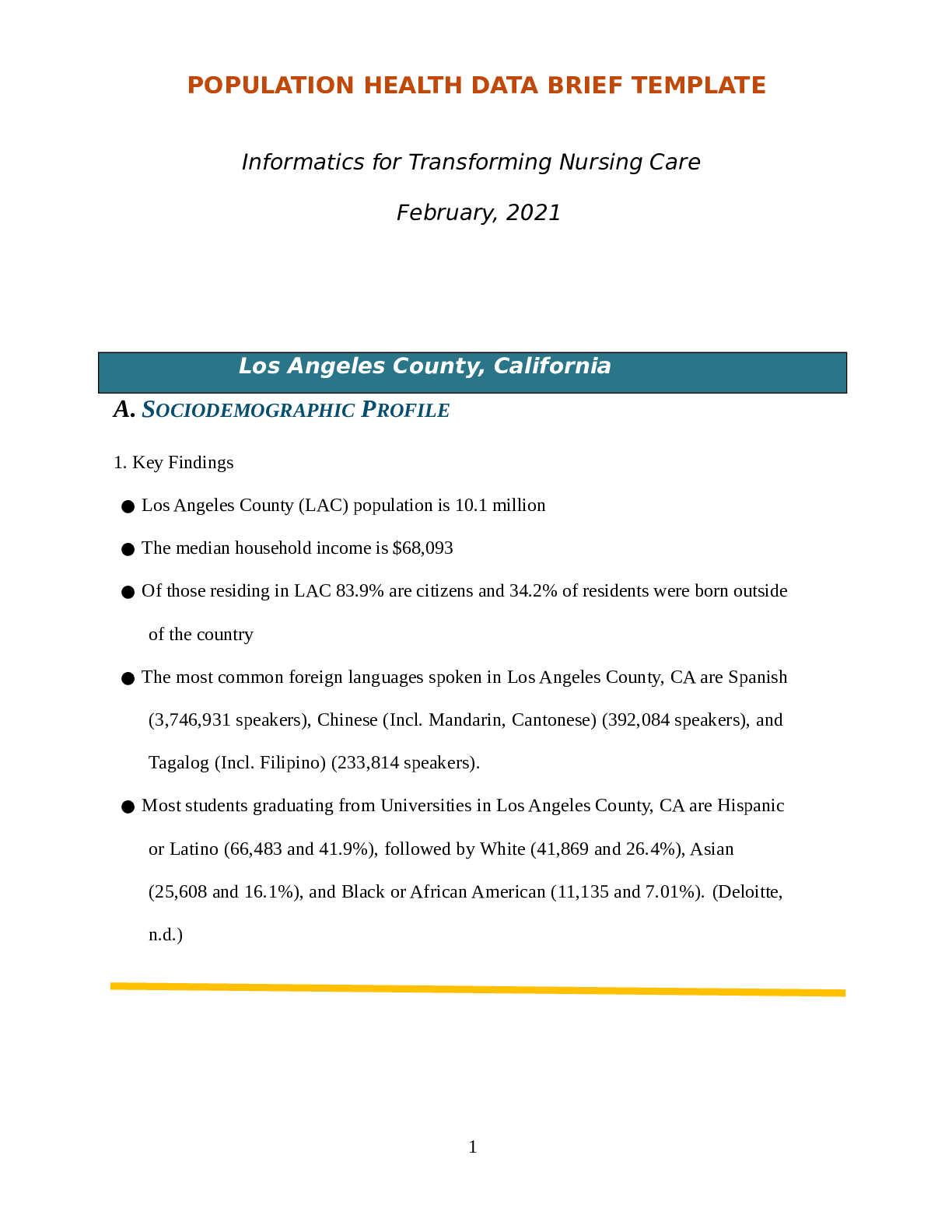Financial Accounting > CASE STUDY > ACCOUNTING 3 Starbucks’ Human Resource Management Practices CASE STUDY | Already Graded A. (All)
ACCOUNTING 3 Starbucks’ Human Resource Management Practices CASE STUDY | Already Graded A.
Document Content and Description Below
Starbucks’ Human Resource Management Practices Abstract The Starbucks Corporation utilizes its human resources practices and policies as a strategy to gain competitive advantage and drive t... he overall success of the company and its globalization efforts. The purpose of this research paper is to analyze Starbucks’ recruiting practices, training structures, and overall human resource management strategies in order to give insight into how the Seattle-based coffee company stands out from its competitors and remains a successful enterprise in spite of the challenges facing it. Starbucks’ Human Resource Management Practices The Starbucks Corporation sees its employees as a key part of its view of itself as a business serving the community; its employees are vital for its growth, helping the business grow and thrive (“Working at Starbucks,” n.d.). To work at Starbucks is much like working with friends, its website claims; the company understands appreciates, respects, and includes different kinds of people. It is a company that also embraces diversity. Starbucks provides all employees and their same-sex or opposite sex-partners comprehensive health benefits that include medical, dental, and vision care as well as tuition reimbursement, stock options, vacation, and the 401 (k) retirement plan (Noe, Hollenbeck, Gerhart & Wright, 2010). Starbucks is also company that practices open communication. It keeps employees or “partners” frequently informed, its senior leaders frequently holding “Open Forum” events to answer employee questions and mitigate issues or concerns. Starbucks believes that it is important to hire those not just for the ability to be trained in cafe work and customer satisfaction, but also those with an aptitude for social consciousness. Its mission is to inspire and nurture the human spirit “one person, one cup, and one neighborhood at a time” (“Our Mission,” n.d.). The company is well-known for its ethical sourcing of coffee from farmers all over the globe and environmental leadership (by 2015 all its cups will be reusable or recyclable). It is also renowned for its community involvement through volunteer work in neighborhoods where stores are located (Noe et al., 2010). Performance Management, Benefits, and Customer Satisfaction Starbucks has offered a variety of training programs to provide employees sufficient knowledge of the company’s values and how to foster it amongst their customers. According to Obloga (2011), “First Impressions” has given insight to baristas as how to interact with customers in terms of service principles. Employees are made aware of the company’s history and learn how to perform coffee preparation and use a cash register. In addition, they learn the right kind of communication skills to interact optimally with customers in order to create the environment that Starbucks aims to promote (Obloga, 2011). Starbucks has tried to develop its human resources practices and make them stronger to the extent that employees have better relationships with their managers and feel connected to the organization as a whole. Starbuck’s has gained admiration and recognition by being a pioneer in offering the same benefits to part-time workers as are offered to full-time employees. Such benefits include health care, dental, and vision insurance (Obloga, 2011). Benefits also cover alternative medical treatments, such as hypnotherapy and naturotherapy. Starbucks additionally offers their employees benefits such as income protection, saving plans, partner discounts, and free drinks on a regular basis. Another unique benefit of Starbucks is their “Adoption Assistance Program,” which reimburses employees a certain amount of expenses incurred during a child adoption process. Noe et al. (2010) stated that such benefits serve to increase employee motivation, recognition, and retention; they also assist in decreasing employee turnover. Fundamentally, Starbucks believes its baristas are the key feature to the Starbucks experience and customer satisfaction. Starbucks wants them to have coffee knowledge and product expertise, providing great customer service. For example, to make sure that customers were delighted and served coffee to high-quality standards, Starbucks closed most of its stores in 2008 for a full day training event (Noe et al., 2010). The training event, known as “Perfect the Art of Espresso,” was held to help baristas deliver high-quality espresso. One activity involved pulling an espresso shot and then evaluating and reflecting upon the process and the product. (Did it take too long or too short a time? Was it the right color?). Staff discussions about how the training would be of use to customers occurred at each store (Noe et al., 2010). This highlights the degree to which the company values the training of its baristas and views the importance of their role in the Starbucks experience. At Starbucks people are said to be its main resource. Hence, training efforts, as noted above, comprise its balanced scorecard; a balanced scorecard involves four perspectives. The learning and growth perspective involves employee training and cultural attitudes of the company. Kaplan and Norton (1996) emphasized that learning is more than training; mentors and tutors should also be within the organization as well as a streamlining of the communication process, utilizing technological tools that allow better interaction among employees, as Starbucks does with “Open Forum.” The customer perspective, which focuses on importance of the customer and customer satisfaction, is essential as noted above; if customers are not satisfied, they will go somewhere else and the company will be left behind. In measuring customer satisfaction, it is important to examine the kinds of processes that go into providing a product or service to those customer groups (“Balanced Scorecard Basics,” n.d.). Therefore, Starbucks values the customer perspective of their balanced scorecard as per the training described. Recruitment Growth, Company Performance, and Work-life Balance The recruitment process is a pivotal strategy for Starbucks to accomplish its objectives in finding the right kinds of personnel to carry out its mission and business strategy. Fortunately for the company, it had experienced periods of accelerated growth, opening up more than four stores and adding 200 employees each day until 2007 (Noe et al., 2010). With such a rapid growth rate, however, it had to assimilate those new hires quickly into the company to meet its growth goals. In the process the company made hasty decisions and cluttered new stores with merchandise whilst losing focus on coffee. Starbucks’ CEO Howard Schultz and other top executives did not earn bonuses in 2008 as a result of the company’s subsequent poor performance. According to Noe et al. (2010), Schultz asked the board of directors that year to decrease his 1.2 million in base pay to $1; the company’s new corporate jet went up for sale. Starbucks closed 300 underperforming stores and laid-off over 6,700 employees. Starbucks also announced that it would no longer be matching employees’ contributions to their 401 (k) retirement plans. However, in spite of store closures and tough times, Starbucks has remained a highly regarded company to work for, reaching in 2013 number 94 on Fortune’s 100 best companies to work for (“100 Best Companies,” n.d.). Its continued success arguably is due to its successful administration of human resources management, denoting all the efforts that Starbucks undergoes to recruit, develop, and retain its employees. Its recruitment strategies involve strategic human resource planning as well as utilizing “social recruitment” online via its career site to target its hiring audience. Once hired, keeping or retaining valuable human capital implies evaluating performance regularly, encouraging success, providing benefits and the ability to undertake the necessary actions to keep them within the organization, including promoting work-life balance (Noe et al., 2010). Work-life balance is the concept of balancing one’s working life with one’s health and well being. In general, it can be a difficult endeavor, particularly in those whom feel overworked and who find it challenging to juggle the demands of their job with the rest of their lives. To help curb job burnout, it is useful for an individual, regardless of where they work, to employ tactics such as building downtime into one’s schedule, dropping activities that deplete time and energy, exercising, and seeking relaxation strategies (Uscher, 2012). Companies and organizations can also play a critical role in creating meaningful work-life balance, Starbucks being a prime example. While one estimate is that less than 30 percent of part-time workers in the United States have paid sick leave or paid time off, at Starbucks part-time employees are eligible for paid sick leave or paid time off if they work 240 hours a quarter (Noe et al., 2010). Human resource management in general has to serve as an internal adviser, and be viewed as open-minded, fair, professional and efficient. Human resources must recruit, develop, and retain employees who possess the skills and vision. It must seek the opportunity to make positive changes to compensation, benefits, and reward and recognition programs and additionally provide training and development opportunities to its employees (Mathis & Jackson, 2009); it must promote work-life balance in the manner Starbucks has done. Core Practices and Values Having a business process perspective entails possessing knowledge of the company’s internal business processes. These processes are measurable and in so doing it is essential that successful companies bring together its products and services with consumer demand. These actions are best handled by those who know the company’s business processes most intimately, not consultants, but rather in the case of Starbucks, its employees. Hence, Starbucks’ human resource management practices help support the company’s business strategy in providing services the customer values. For example, Starbucks’ Frappucino was a drink invented by one of its employees (Noe et al., 2010). Initially, Starbucks’ leadership including thought it was a horrible idea. They fought it out in many meetings but the employee in question kept getting more and more data supporting her case for how much customers liked it. Upper management finally gave in and gave the go ahead to begin making it, and it now is a $1 billion a year product. Therefore, the value of a product or service is determined by its quality and how closely the product fits customer needs. In enhancing Starbucks’s competitiveness, its willingness to listen to employee input, allows emergent strategies to come directly from the marketplace by determining and responding to the exact mix of customer desires (Noe et al., 2010). Accordingly, Starbucks aims to have the right kinds of people in place who have the skills and foresight to evolve the company. “If people relate to the company they work for, if they form an emotional tie to it and buy into its dreams, they will pour their heart into making it better. When employees have self-esteem and self respect they can contribute so much more; to their company, to their family, to the world.” Noe et al. (2010) wrote that this statement of Schultz’s exemplifies the increasing importance of human capital in developing and maintaining competitive advantage. To maintain competitive advantage involves harmonizing the four perspectives of Starbucks’ balanced scorecard, synchronizing them together as would a conductor in a symphony comprised of different instruments. The responsibility of fostering the harmony perspective is best led by who are adept in all areas of Starbucks’ corporate instrumentation, and from a bird’s eye view perspective can transformatively align those areas that are out of balance, synergizing them, thereby reinforcing the organization’s stated mission. To better understand the degree to which Starbucks harmonizes the four business scorecard perspectives, let us first re-examine its mission statement. A mission statement is a short written statement of the purpose of a company or organization. The statement should guide the actions of the entity, provide a sense of direction, and guide decision-making in a manner that ultimately synchronizes the aspects of the scorecard in a clear and coherent strategy. A poor understanding of its strategy formulation may result in an entity choosing strategies it is not capable of pursuing (Wright, McMahan & Williams 1994). Notably, Starbucks has been repositioning itself in the marketplace and this is reflected in its change of its mission statement. Its old mission statement was "To establish Starbucks as the premier purveyor of the finest coffees in the world while maintaining our uncompromising principles as we grow" (Thompson & Strickland, 1997). Starbucks has since changed its mission statement to a broader and deeper statement of purpose as noted above. Let us contextualize Starbucks’ mission statement further by examining how it influences its practices and values. If inspiring and nurturing the human spirit involves having passion, certainly Starbucks is passionate about the quality of their products and look of their cafes, their newest store in Amsterdam being a prime example. Not only do they source high quality coffee beans, roasting them with great care, they have recently innovated in Amsterdam with high quality coffee making equipment - the Clover (R) brewing system at their first store equipped with its own in-house bakery. There are new design aesthetics, an amplified coffee theater, and the depth of connection to Dutch culture that is according to their website setting the stage for its future across Europe (“The Clover Brewing System,” n.d.). From its infancy, the Starbucks marketing strategy has consistently focused on creating a “third place” for people to go to between work and home. What sets it apart from apart from traditional coffee houses in my current hometown of Vienna, Austria, for example, is its passion for unique products that cater more to students and young urban professionals, in addition to its ability to create a unique and relaxing atmosphere catered to more healthy minded people. This differentiates it from the Viennese coffee houses that commonly allow smoking, have no internet access, no selection of music, and have no unique beverage products on the menu to the extent Starbucks offers. As a result Starbucks cafes in Vienna have become centers for socializing and a common meeting point for many according to my experience. The company has managed to create a cafe experience that is comfortable, attractive, and entertaining in order to attract customers and keep them coming back. Therefore, “third place” is central to Starbucks’ mission statement, practices, and values. As are many successful companies today, Starbucks is also subject to the scrutiny that it has not achieved its success at the expense and exploitation of others. In light of this, the company is passionate about ethically sourcing their coffee beans and caring for and improving the lives of people who grow them (Noe et al., 2010). Nevertheless, when I was living in San Francisco, California in the mid-1990s, the opening of a Starbucks was often met with objection from local cafes, their owners, and patrons alike. Starbucks appeared rather ruthless to many at that time in establishing themselves quickly in nearby locations in neighborhoods where there was a strong local connection to the community. However, notwithstanding, Starbucks seeks be “good neighbors” as per its postings on its website (“Being a Responsible Company,” n.d.). Competitive Challenges No matter its efforts to be an ethical and sound company on all fronts, Starbucks began having considerable trouble beginning in 2008, not only with falling revenues from the recession, but also due to increased competition from primarily McDonald's and Dunkin' Donuts; both had entered the quality coffee market by that time (Brush, 2011). Brush wrote that though it had taken awhile, the two chains finally noticed the huge profits Starbucks was making from coffee sales. Let us focus on the threat from McDonald’s. Initially, McDonald's knew it could not sell $5 coffee drinks like Starbucks does. Starbucks and McDonald's have differing customer bases: one that tends to be more affluent, the other a bit more price sensitive. Keenly aware of its customer base, McDonald's is "always keeping an ever-vigilant eye on everyday affordability, which is the most important thing for our consumers," said CEO Jim Skinner said during a company conference call with shareholders. "They get pinched everywhere," Skinner added. "They should not suffer the same fate at McDonald's" (Brush, 2011). Nonetheless, McDonald’s has since begun selling premium coffee and it has been big hit, with sales growing remarkably. "We believe McDonald's could evolve into Starbucks' fiercest rival in the specialty coffee segment," stated analyst R.J. Hottovy, who in 2011 covered both companies for Morningstar (Brush, 2011). The advent of McCafè’s inside the main and the often “going green” McDonald’s restaurants is a notable attempt to create its own version of “third place,” all which puts Starbucks in a kind of quandary. According to Brush (2011), Starbucks has needed to take care to not cheapen its brand whilst responding to this impressive challenge from McDonald's. Starbucks has navigated through this market issue well so far. It has attracted customers with its premium coffee brand, Seattle's Best Coffee, at more than 30,000 quick-service partnerships, their cooperation with Subway being one example (Brush, 2011). “This gives the company exposure to this space without putting the Starbucks name into the fray. By stealthily moving into this part of the market, Starbucks looks more like McDonald's, at least behind the scenes, without diluting the premium aspects of its name in the eyes of the public,” wrote Brush (2011). Unions, Equitable Pay, and Working Conditions In spite of Starbuck’s successes in many quick-service partnerships and in its overall strategy to keep McDonald’s in particular at bay from its customer base domestically and internationally, separate human resource management issues still abound. Specifically, there have been issues raised in the balanced scorecard by segments of employees in terms of equitable pay. According to Noe et al. (2010) external equity takes place when an employer pays a wage rate on par with the wages current in “external” job markets. Internal equity exists when an employer pays wages on par with the relative "internal" value of each job. This is determined according to what the employer perceives is of the importance of the labor being performed (Romanoff, Boehm & Benson, 1986). In May 2004, Starbucks's workers at the 36th and Madison store in midtown Manhattan organized the first Starbucks barista union in the United States. The union drive had its origins in barista's complaints that a starting wage of $7.75 an hour was not a living wage in New York City and that Starbucks had refused to guarantee a regularity of hours per week (Allison, 2007). “They're underpaid, their hours stink, and many can't afford the company's health insurance,” stated Daniel Gross in 2007, an Industrial Workers of the World (IWW) organizer who had spent three years as a Starbucks barista in New York. "Starbucks has falsely cashed in on a socially responsible image," said the energetic Fordham Law School student who, according to Allison (2007), had become involved with the union around the time he left a prior job at Borders Books and Music. "There's a tremendous amount of discontent among Starbucks workers," stated Gross. Two years before the Allison (2007) Seattle Times article was published, Starbucks had agreed to pay more than $165,000 to settle unfair-labor-practices complaints, although it admitted no wrongdoing (Allison, 2007). Perhaps, like many corporate executives, Schultz, as stated by Allison, believes his company treats employees so well that they should not want a union. In his 1997 book about Starbucks, Shultz wrote about building trust with employees after buying the company a decade earlier. "I was convinced that under my leadership, employees would come to realize that I would listen to their concerns," Schultz wrote. "If they had faith in me and my motives, they wouldn't need a union,” he wrote (Schultz, 1997). In deciding what to pay employees, Romanoff et al. (1986) stated that employers should carefully define the appropriate market(s) to assure accurate external wage comparisons. Defining the market too narrowly can result in wages that are higher than necessary. Should a company that is doing business in two locations define its pay practices solely in terms of its metropolitan labor market, it could set wages that are unnecessarily high for its rural areas. Therefore, geographic location is a major determiner of what to pay employees (Noe et al., 2010). Hence, $7.75 an hour was arguably not a living wage in New York City in 2004, nor would it be today, adjusted for inflation. Moreover, on the Starbucks Workers Union website there is clear discontent with the company with claims that Starbucks has sought to please its shareholders on the backs of employee labor. The organizers appeal to employees and supporters alike to sign the following petition: As Starbucks made record profits of $1.7 billion this year, enough to give $8000 to every single Starbucks worker. But instead of compensating us fairly for our hard work, CEO Howard Schultz handed out millions in dividends to wealthy investors while squeezing us like never before. Since 2008, under-staffing has gotten worse, our pay has remained stagnant with smaller merit increases, our health insurance premiums have doubled, our benefits have been cut, and we have been saddled with more labor-intensive tasks like up-selling VIA and other products and brewing coffee in "cadence" every 6 minutes (“Unite for Good Jobs at Starbucks,” 2012). Such petition efforts are arguably healthy mechanisms for union oriented Starbucks employees and their supporters to vent their feelings and bring awareness to their views on equitable pay and overall working conditions. Starbucks’ Experience Globally When Starbucks has done well internationally, it has grasped the simple concept that McDonald’s apparently has understood when it comes to HRM and business practices: when in Rome, do as the Romans do. However, Starbucks could arguably go further. While the coffee chain offers the same espressos, Frappuccino and lattes globally, the McDonald’s menu changes according to the dictates of local culture and tastes. In Japan, a consumer is able to purchase an Ebi Filet-O (a shrimp burger), while McDonald’s customers in Turkey can get kebabs, and the McCurry Pan is available in India (Herron, 2008). In the past, Starbucks has sometimes failed to understand local social values, mores, customs, and traditions most notably in Australia, Israel, and Beijing, China, where a Starbucks’ location in the former Imperial Palace in the centuries-old Forbidden City closed in July 2007 (Herron, 2008). Herron stated that the coffee shop had been a source of continuing controversy since its opening in 2000. Protesters had felt the presence of the American chain at this location was an affront to Chinese culture. Herron also noted that Berg (2008) had written of the pitfalls of globalization, stating: “The secret of the company’s success in the American market wasn’t that it sold coffee. It sold coffee culture. The other aspect of Starbucks’ appeal in the U.S. has been its establishment of the cafe as a social hub (i.e. as a “third place”). But when Starbucks came to Australia to bring coffee and its cafe culture to the masses, it found that we already had it. Particularly in Melbourne, we have better coffee and more relaxing cafes than anything that Starbucks brought with it.” Therefore, the more Starbucks seeks to integrate itself with the local culture’s values and expectations, in the manner McDonald’s has done, the more appeal it will have. Such success inevitably draws on having the right people in place on all levels of local management. Upper management and employees alike should be sensitive to these aims and able to perform effectively and transformatively. Certainly the mission, values, and best practices of Starbucks appear to be in alignment with these HRM goals. Yet practice shall make it more perfect. Conclusions Drawn According to Noe et al. (2010) HRM strategies should support the overall business strategy. Short and long term benefits can come out of supporting a company’s business strategy in general, as has been the case in Starbucks’ application of its best practices and relevant HRM activities. In terms of applying specific and guided human resource strategies, first it is necessary for Starbucks’ upper management to continue to understand HRM activities in terms of their strategic value, particularly in so far as cultural sensibilities, equitable pay, and strategic direction are concerned. Starbucks, though not perfect, has overall been successful in this regard. It is vital too, for Starbucks’ upper management to maintain their efforts in authentic and transformational leadership activities, as opposed to falling into a more transactional tone where there is too much focus on record keeping, compliance, and disciplinary measures. Such efforts involve scanning the internal and external environments of the company, identifying strategic business opportunities as well as people issues, then developing catered and innovative HRM strategies; communicating those strategies and disseminating them effectively to their people is what should follow (Noe et al., 2010). As we have reviewed in this research paper, Starbucks has done this well on many of these fronts, which has kept it a successful company in spite of the issues pressing it as per those hitherto described. References Allison, M. (2007). Union struggles to reach, recruit starbucks workers. Retrieved from http://www.lrwarehouse.com/PDF/2007-01/LU_2348.pdf Balanced Scorecard Basics. (n.d.). Retrieved from http://www.balancedscorecard.org/BSCResources/AbouttheBalancedScorecard/tabid/5 5/Default.aspx Being a Responsible Company. (n.d.). Retrieved from http://www.starbucks.com/responsibility Brush, M. (2011). McDonald’s or starbucks: Who wins? Retrieved from http://money.msn.com/investment-advice/mcdonalds-or-starbucks-who-wins- brush.aspx Berg, C. (2008). Memo starbucks: Next time try selling ice to eskimos. Retrieved from http://www.theage.com.au/opinion/memo-starbucks-next-time-try-selling-ice-to- eskimos-20080802-3oyp.html?page=-1 Herron, M. (2008). Why starbucks failed in australia. Retrieved from http://www.pajamadeen.com/business-news/why-starbucks-failed-in-australia Kaplan R. & and Norton, D. (1996). Using the balanced scorecard as a strategic management system. Harvard Business Review: 76. Obloga, E. (2011). Starbucks’ hr policies and practices. Retrieved from http://www.scribd.com/doc/75800799/Starbucks-HR-Policies-and-Practices 100 Best Companies to Work For. (n.d.). Retrieved from http://money.cnn.com/magazines/fortune/best-companies/2013/list/?iid=bc_sp_full Our Mission. (n.d.). Retrieved from http://www.starbucks.com/about-us/company- information/mission-statement Mathis, R. & Jackson, J. (2012). Human resource management: Essential perspectives (6th ed.). Mason: South-Western . Noe, R. A., Hollenbeck, J. R., Gerhart, B., & Wright, P. M. (2010). Human resource management (7th ed.). New York: McGraw-Hill. Romanoff, K., Boehm, K., and Benson, E. (1986). Pay equity: Internal and external considerations. Compensation Benefits Review. vol. 18 no. 6. (pp.17-25). Schultz, H., & Yang, D. J. (1997). Pour your heart into it, how starbucks built a company one cup at a time. (1st ed.). New York City: Harper Collins. The Clover Brewing System (n.d.). Retrieved from http://www.starbucks.com/coffee/learn/clover Thompson, A. A., & Strickland, A. J. (2000). Strategic management, concepts and cases. McGraw-Hill/Irwin. Unite for Good Jobs at Starbucks. (2012). Retrieved from http://starbucksunion.org/node/10050 Uscher, J. (2012). 5 tips for better work-life balance. Retrieved from http://www.webmd.com/balance/guide/5-strategies-for-life-balance. Working at Starbucks. Retrieved from http://www.starbucks.com/career-center/working-at- starbucks Wright, P., McMahan, G., & McWilliams, A. (1994). Human resources and sustained competitive advantage: A resource based perspective. International Journal of Human Resource Management 5. (pp. 301-26). [Show More]
Last updated: 2 years ago
Preview 1 out of 17 pages
 (1).png)
Buy this document to get the full access instantly
Instant Download Access after purchase
Buy NowInstant download
We Accept:

Reviews( 0 )
$12.00
Can't find what you want? Try our AI powered Search
Document information
Connected school, study & course
About the document
Uploaded On
Sep 27, 2021
Number of pages
17
Written in
Additional information
This document has been written for:
Uploaded
Sep 27, 2021
Downloads
0
Views
114



